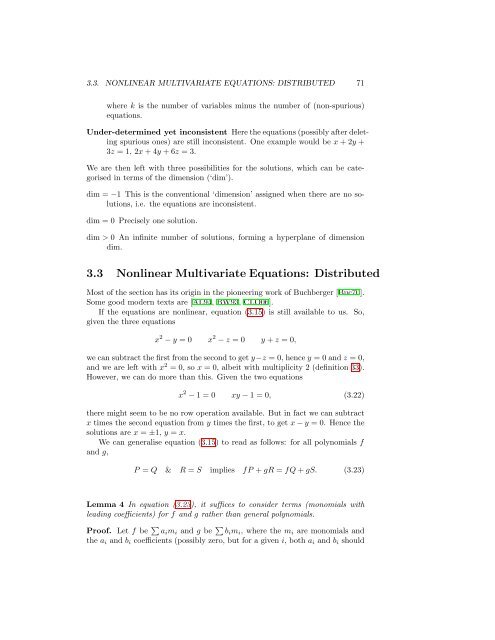Contents - Student subdomain for University of Bath
Contents - Student subdomain for University of Bath
Contents - Student subdomain for University of Bath
You also want an ePaper? Increase the reach of your titles
YUMPU automatically turns print PDFs into web optimized ePapers that Google loves.
3.3. NONLINEAR MULTIVARIATE EQUATIONS: DISTRIBUTED 71<br />
where k is the number <strong>of</strong> variables minus the number <strong>of</strong> (non-spurious)<br />
equations.<br />
Under-determined yet inconsistent Here the equations (possibly after deleting<br />
spurious ones) are still inconsistent. One example would be x + 2y +<br />
3z = 1, 2x + 4y + 6z = 3.<br />
We are then left with three possibilities <strong>for</strong> the solutions, which can be categorised<br />
in terms <strong>of</strong> the dimension (‘dim’).<br />
dim = −1 This is the conventional ‘dimension’ assigned when there are no solutions,<br />
i.e. the equations are inconsistent.<br />
dim = 0 Precisely one solution.<br />
dim > 0 An infinite number <strong>of</strong> solutions, <strong>for</strong>ming a hyperplane <strong>of</strong> dimension<br />
dim.<br />
3.3 Nonlinear Multivariate Equations: Distributed<br />
Most <strong>of</strong> the section has its origin in the pioneering work <strong>of</strong> Buchberger [Buc70].<br />
Some good modern texts are [AL94, BW93, CLO06].<br />
If the equations are nonlinear, equation (3.15) is still available to us. So,<br />
given the three equations<br />
x 2 − y = 0 x 2 − z = 0 y + z = 0,<br />
we can subtract the first from the second to get y−z = 0, hence y = 0 and z = 0,<br />
and we are left with x 2 = 0, so x = 0, albeit with multiplicity 2 (definition 33).<br />
However, we can do more than this. Given the two equations<br />
x 2 − 1 = 0 xy − 1 = 0, (3.22)<br />
there might seem to be no row operation available. But in fact we can subtract<br />
x times the second equation from y times the first, to get x − y = 0. Hence the<br />
solutions are x = ±1, y = x.<br />
We can generalise equation (3.15) to read as follows: <strong>for</strong> all polynomials f<br />
and g,<br />
P = Q & R = S implies fP + gR = fQ + gS. (3.23)<br />
Lemma 4 In equation (3.23), it suffices to consider terms (monomials with<br />
leading coefficients) <strong>for</strong> f and g rather than general polynomials.<br />
Pro<strong>of</strong>. Let f be ∑ a i m i and g be ∑ b i m i , where the m i are monomials and<br />
the a i and b i coefficients (possibly zero, but <strong>for</strong> a given i, both a i and b i should












![[Luyben] Process Mod.. - Student subdomain for University of Bath](https://img.yumpu.com/26471077/1/171x260/luyben-process-mod-student-subdomain-for-university-of-bath.jpg?quality=85)



